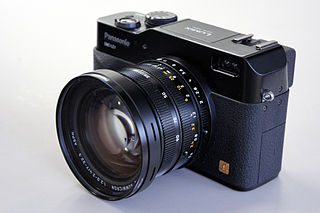
Lumix is Panasonic's brand of digital cameras, ranging from pocket point-and-shoot models to digital SLRs.

The Micro Four Thirds system is a standard released by Olympus and Panasonic in 2008, for the design and development of mirrorless interchangeable lens digital cameras, camcorders and lenses. Camera bodies are available from Blackmagic, DJI, JVC, Kodak, Olympus, Panasonic, Sharp, and Xiaomi. MFT lenses are produced by Cosina Voigtländer, DJI, Kowa, Kodak, Mitakon, Olympus, Panasonic, Samyang, Sharp, Sigma, SLR Magic, Tamron, Tokina, TTArtisan, Veydra, Xiaomi, Laowa, Yongnuo, Zonlai, Lensbaby, Kowa, Venus Optics and 7artisans amongst others.

The Panasonic Lumix DMC-GH1 is a digital mirrorless interchangeable lens camera adhering to the Olympus and Panasonic developed Micro Four Thirds System (MFT) system design standard. Panasonic classified the GH1 as a hybrid stills/video camera and the GH1 was introduced and marketed as a higher end camera than Panasonic's first MFT camera, the stills only, non-video capable Lumix DMC-G1.

A mirrorless camera is a photo camera featuring a single, removable lens and a digital display. The camera does not have a reflex mirror or optical viewfinder like a digital single-lens reflex (DSLR) camera, but may have an electronic viewfinder. Many mirrorless cameras retain a mechanical shutter. Like a DSLR, a mirrorless camera accepts any of a series of interchangeable lenses compatible with its lens mount.

The Panasonic Lumix DMC-GH2 is a digital camera with HD video recording capability that is part of the Micro Four Thirds system. Though commonly referred to as a DSLR camera, it has no mirror or optical viewfinder, but has instead both a fold-out LCD screen and a electronic viewfinder.
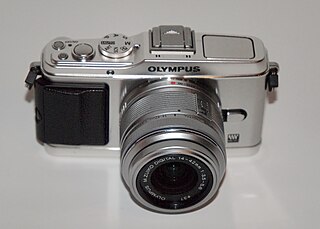
The Olympus PEN E-P3 announced on 30 June 2011 is Olympus Corporation's seventh camera that adheres to the Micro Four Thirds (MFT) system design standard. The E-P3 succeeds the Olympus PEN E-P2, and was announced in concert with two other models, the Olympus PEN E-PL3, and the Olympus PEN E-PM1.

The Sony α77 was the flagship for Sony's midrange Alpha SLT camera line.

The Panasonic Lumix DMC-GH3 is a digital mirrorless interchangeable lens camera (MILC) manufactured by Panasonic. It is the successor to the Panasonic Lumix DMC-GH2 and was announced in September 2012 at photokina. It was available from November 2012.
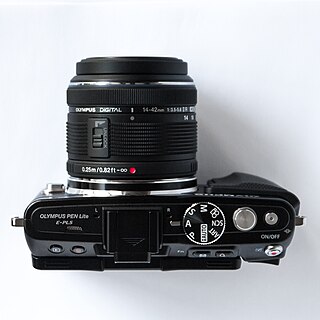
The Olympus PEN E-PL5, announced on September 17, 2012 is Olympus Corporation's tenth camera that adheres to the Micro Four Thirds (MFT) system design standard. The E-PL5 succeeds the Olympus PEN E-PL3, and was announced in concert with one other model, the Olympus PEN E-PM2.

The Panasonic Lumix DMC-GX7 announced in August 2013, is a Micro Four Thirds compact mirrorless interchangeable lens camera. It was Panasonic's first Micro Four Thirds camera with a built-in in-body stabilization system (IBIS) and has a built-in EVF. Panasonic uses 2-axis in-body stabilization allowing the use of shutter speeds 1 to 2 stops slower than without stabilization, compared to the 4 to 5 stops of improvement offered by Olympus' 5-axis stabilization.
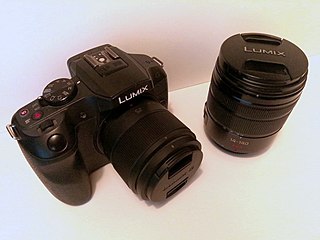
Panasonic Lumix DMC-G6 is a Micro Four Thirds system camera made by Panasonic Lumix. The model was announced in April 2013. The highest-resolution pictures it can record is 16.05 megapixels and the sensor is a Live MOS The camera is not a direct replacement of the Panasonic Lumix DMC-G5, but set in between the G5 and the Panasonic Lumix DMC-GH3.
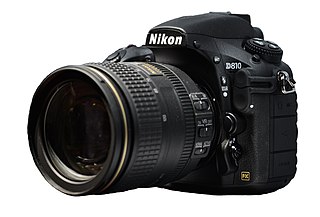
The Nikon D810 is a 36.3-megapixel professional-grade full-frame digital single-lens reflex camera produced by Nikon. The camera was officially announced in June 2014, and became available in July 2014.
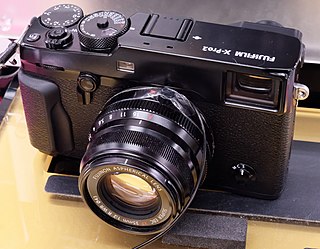
The Fujifilm X-Pro2 is a mirrorless interchangeable-lens digital camera announced in January 2016. It is part of Fujifilm's X-Series of cameras, the successor to the X-Pro1. Sales began on 3 March 2016.
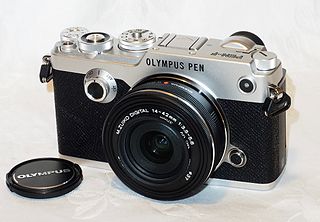
The Olympus PEN-F is a mirrorless interchangeable-lens camera in the Micro Four Thirds system, released in 2016. It is the part of the digital PEN series. The PEN-F pays tribute to the similarly named PEN F half-frame 35mm film SLR camera from 1963.

The Panasonic Lumix DC-GH5 is a Micro Four Thirds mirrorless interchangeable lens camera body announced by Panasonic on 4 January 2017.

The Panasonic Lumix DC-GH5S is a Micro Four Thirds mirrorless interchangeable lens camera body announced and released by Panasonic in January 2018.

The Olympus OM-D E-M1 Mark III is the third iteration of the flagship camera in the series of OM-D mirrorless interchangeable-lens cameras produced by Olympus on the Micro Four-Thirds system. Released on February 28, 2020, it replaced the Olympus OM-D E-M1 Mark II.

The Olympus OM-D E-M5 Mark III is the third iteration of the enthusiast-level mirrorless interchangeable-lens camera produced by Olympus on the Micro Four-Thirds system. The camera is the successor to the Olympus OM-D E-M5 Mark II and was released on November 15, 2019.
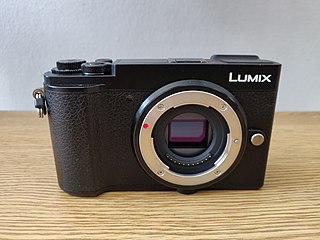
Panasonic Lumix DMC-GX9 is a digital rangefinder-styled mirrorless interchangeable-lens camera announced by Panasonic in February, 2018.























